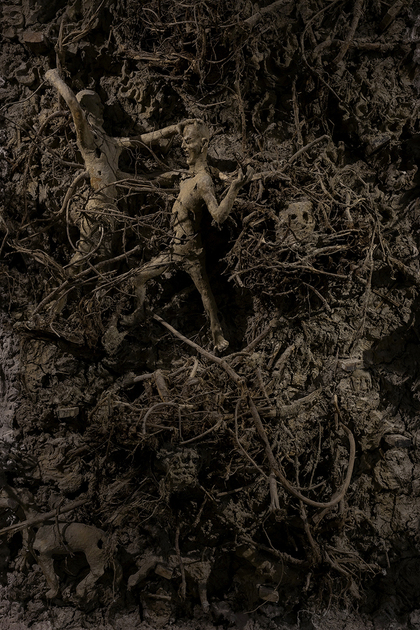-
From Current Issue
-
- Editor’s Letter Fire in the Heart
- Reviews I Gusti Ayu Kadek Murniasih
- Reviews 11th Seoul Mediacity Biennale: “One Escape at a Time”
- Dispatch Networked China
- One on One Monira Al Qadiri on Yukio Mishima
- Essays The rise of independent art spaces in pandemic-era Shanghai
- Features Tuan Andrew Nguyen
- Table of Contents
- Web Exclusives
- Archive
- Subscribe

R
E
V N
E
X
T
Yang Song posits that “[trees] could become people, and people could become trees.” This insight comes from a moment of reflection on the cycle of life. One day, while walking in the woods, Yang realized how dead foliage disintegrates and becomes part of the soil, providing nutrients to the roots of a tree and hence physically becomes part of that tree. The artist reflected further, and reached the conclusion that, upon death, he will return to the earth and possibly be integrated into a tree, just like those leaves. His show “Askr Yggdrasils” is an attempt to connect the world of leaves, roots and trees to that of humans, framed by the artist’s interpretation of the Buddhist concept of reincarnation.
Though the exhibition’s English title taps into Norse mythology—“Yggdrasil” refers to an ash tree that holds in its branches and roots nine worlds, including a realm inhabited by humans, and another where the dead reside—the exhibition’s Chinese name, “Mugentu,” contains the characters for the elements that are used in the works, namely wood (“mu”) and earth (“tu”). “Gen,” the Taoist trigram that represents mountains, is claimed by the artist as a symbolic representation of the human form.
In Gallery Yang’s dimly lit main space, a large installation of wood and shaped clay, Askr Yggdrasils (2016), is a section of woodland earth raised to stand vertically, revealing a vivid tableau of small figures, animals and ghastly creatures entangled in the roots and soil. With this installation, the artist introduces the visual theme of an underground world teeming with life.
That concept is carried forward in the series Askr Yggdrasils No. 1 to No. 3 (2015–16), in which the idea of rebirth is introduced. Here, skillfully crafted full-scale clay sculptures sit attached to the large root systems in various positions. The artist chooses to let the contours of the root guide the figures’ poses, such as the contemplative pose of a classical “Thinking Bodhisattva” in Askr Yggdrasils No. 3.
A pair of standing figures that face each other, Root No. 1 and Root No. 2 (both 2016), make sense when viewed as the show’s end point. Here, the artist’s attempt to depict a cycle of dead leaves becoming trees and finally being reincarnated as humans—one male, one female—is fully realized. They are no longer in supine or seated positions like those found in the other works, and each has a long tree trunk protruding from its back and vestiges of roots in its anterior. Their medium is different from the other figures’ too: the clay has gone through a firing process to become pottery. The statues are no longer a pale and calming gray, but instead are a strong terracotta red. Whereas in Askr Yggdrasils No. 1 to No. 3, the figures’ genders were not distinct, Root No. 1 and Root No. 2 are clearly identifiable as male and female. Here, the presence of masculine and feminine elements provides the condition for new life to be formed. This pair of artworks symbolizes fully matured humans leaving behind the underground world of soil and roots, but the fired figures do not fit in visually with the rest of the show and its gradual, organic transformation.
Although trained in Western sculpture and aesthetics, Yang draws deeply from Eastern artistic traditions when making images. Yang’s close study of ancient Chinese Buddhist statues, especially those found in the temples of Shanxi Province, is noticeable throughout the exhibition. The exaggerated expressions found in some of the sculptures, such as Root No. 1, closely resemble those of Buddhist luohan (arhats), and several of the faces in Askr Yggdrasils are commonly seen on statues in Buddhist temples. These visages closely resemble traditional forms without reinterpretation, reducing the strength of the artist’s voice. The impact of Yang’s work could be stronger if the artist developed his own visual language for the faces of his key figures, as he has done in the overall concept and execution of the show.
An artist of the post-80s generation, Yang has fully embraced craftsmanship, expending three years to create the artworks presented in “Askr Yggdrasils.” The all-too-common, sterile white cube experience was supplanted by immersion in a magical world, with a powerful new interpretation of reincarnation and our connection with the natural world.
YANG SONG, Root No. 1, 2016, wood and fired clay, 168 x117 x 430 cm; Root No. 2, 2016, wood and fired clay, 160 × 150 x 380 cm. Installation view of “Askr Yggdrasils” at Gallery Yang, Beijing, 2017. Courtesy Gallery Yang.
Yang Song’s “Askr Yggdrasils” is on view at Gallery Yang, Beijing, until April 23, 2017.
To read more of ArtAsiaPacific’s articles, visit our Digital Library.







